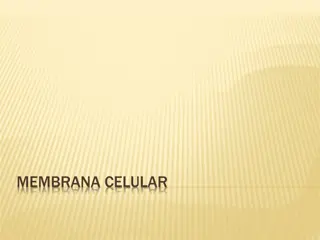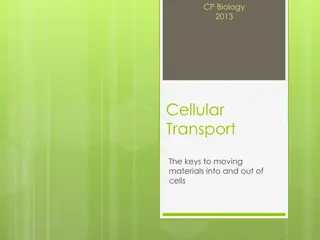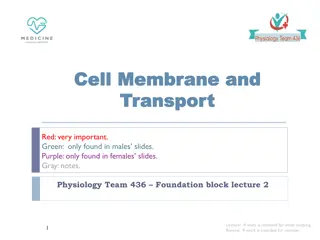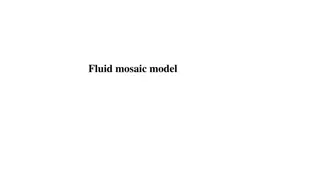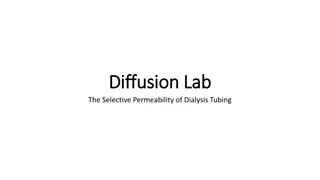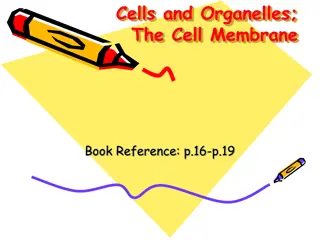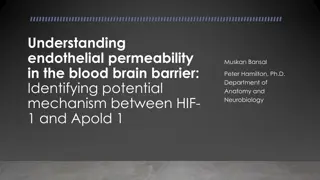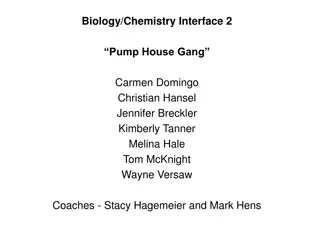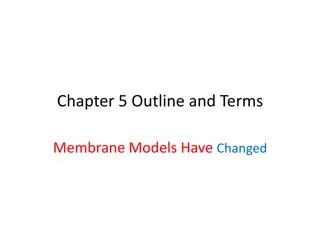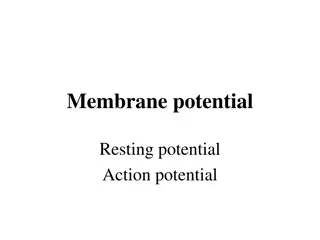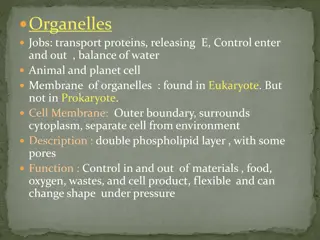Understanding Membrane Proteins and Cell Membrane Permeability
Cell membranes consist of phospholipid bilayers with embedded proteins, including integral and peripheral proteins. Integral proteins span the membrane, while peripheral proteins interact with the surface. Only non-polar molecules can pass through the membrane directly, while charged ions, polar molecules, and water require alternative routes.
Download Presentation

Please find below an Image/Link to download the presentation.
The content on the website is provided AS IS for your information and personal use only. It may not be sold, licensed, or shared on other websites without obtaining consent from the author. Download presentation by click this link. If you encounter any issues during the download, it is possible that the publisher has removed the file from their server.
E N D
Presentation Transcript
Key Area 1.3 Membrane Proteins Unit 1 Cells and Proteins Advanced Higher Biology Miss Aitken
Recap on the Cell Membrane In N5, we learned that the membrane of cells is made up of a bi-layer of phospholipids with proteins embedded in the layers. A phospholipid molecule has a hydrophilic head and a hydrophobic tail.
Membrane Proteins There are two types of proteins found in the cell membrane: Integral proteins Peripheral proteins
Integral Proteins Penetrate the hydrophobic interior and form strong hydrophobic interactions with regions of hydrophobic R groups. Some only extend partly through the membrane and some are transmembrane proteins (span the width of the membrane).
Peripheral Proteins Not embedded in the membrane instead they form ionic and hydrogen bonds to the surface of the membrane. Have hydrophillic R groups on their surface Many peripheral proteins interact with the surfaces of integral proteins.
Membrane proteins Reworded slightly to help you understand and remember: The main difference between integral and peripheral proteins is that integral proteins are embedded in the whole bilayer whereas peripheral proteins are located on the inner or outer surface of the phospholipid bilayer.
What can pass through the cell membrane directly? Oxygen (by diffusion) Carbon dioxide (by diffusion) Hydrophobic signalling molecules Thyroxine Steroids Only non-polar molecules can pass through the cell membrane directly.
What cannot pass through the cell membrane directly? Charged ions H+and Na+ Hydrophilic amino acids Polar molecules Water Glucose These molecules require an alternative route
Facilitated Diffusion DEFINITION: The passive transport of substances across the membrane through specific transmembrane proteins.
How do molecules cross the cell membrane? To perform specialised functions, different types of cell have different types of proteins in their cell membrane to help move molecules across.
Channel Proteins A type of integral protein These proteins function by having a hydrophillic channel that certain molecules or ions can use as a tunnel through the membrane. Most channels are highly selective they only let one type of molecule through. For example, the channel protein aquaporin facilitates the passage of water molecules.
Channel Proteins Some channel proteins can be opened or closed to allow/disallow diffusion of a molecule/ion. These are called gated channels there are 2 types. Ligand-gated: A signal molecule binds to the channel protein and changes its shape/opens or closes gate. Voltage-gated: A change in ion concentration across the cell membrane causes a change in the channel protein and it opens or closes.
Transporter Proteins Another type of integral protein Sometimes called carrier proteins Specific to one substance These proteins hold onto their passengers and change their shape in a way that shuttles them across the membrane. Transporters alternate between two conformations so that the binding site is exposed to one side of the membrane, then the other.
Movement of Ions and Molecules Across Membranes Ions/Polar molecules must go through a protein channel in order to pass through the cell membrane There are specific transmembrane proteins which act as sodium channels etc. Some transmembrane proteins control the concentration gradient across a membrane by controlling numbers of ions on either side.
Transporter Proteins Also involved in facilitated diffusion Also specific to one type of ion/molecule Main difference: Transporter proteins bind to ions or molecules and this causes a conformational change in the protein. Protein actually passes ions or molecules across the membrane rather than providing a route through. Example: GLUT4 glucose transporter
The Sodium Potassium Pump The sodium potassium pump is a vital transmembrane transporter protein. It does active transport moving sodium ions out of the cell whilst moving potassium ions into the cell. It uses ATP to do this as it is moving ions against their concentration gradient. When thinking about the sodium potassium pump, it is vital to remember that Na+ions and K+ ions are both POSITIVE.
The Sodium Potassium Pump The sodium potassium pump moves 3 sodium ions out for every 2 potassium ions it moves into the cell. The sodium potassium pump has two stable conformational states. There are six steps in the movement of the sodium potassium pump.
The Sodium Potassium Pump Step 1: The transporter protein has it s ion binding sites exposed to the cytoplasm (inside of cell). This conformation has an affinity for sodium ions and this means 3 sodium ions will bind.
The Sodium Potassium Pump Step 2: When the ions attach to the pump, the pump is then able to hydrolyse ATP. Breaking down ATP to ADP + Pi means that the phosphate can be used to phosphorylate the pump and this causes a conformational change.
The Sodium Potassium Pump Step 3: This new shape has it s ion binding sites exposed to the outside of the cell. The affinity for sodium ions is now low, so the pump releases them.
The Sodium Potassium Pump Step 4: At the same time, the affinity for potassium ions is high so 2 potassium ions bind to the binding sites. This triggers dephosphorylation, the removal of the phosphate group.
The Sodium Potassium Pump Step 5: Dephosphorylation causes the protein to change it s shape to the first conformation, thus exposing the binding sites to the cytoplasm again.
The Sodium Potassium Pump Step 6: This conformation has a low affinity for potassium ions so the pump lets them go into the cytoplasm. The pump then reverts back to stage 1 as it has a high affinity for sodium ions, and so on...
The Sodium Potassium Pump Why is this so important? It s found in most animal cells. Reasons: Maintains osmotic balance in cells Allows sodium ion gradient in glucose symport Generates a gradient in kidney tubules Allows resting potential in neurons
Coupled Transport The movement of one molecule downhill along it s concentration gradient powers the movement of another uphill against it s concentration gradient. Example: glucose symport process
Specialisation Different tissues in a multicellular organism have different types of channel and transporter proteins in their membrane to move different materials across their cell membranes. e.g: glucose symporters are only found in the cells lining the small intestine and kidney nephron.




